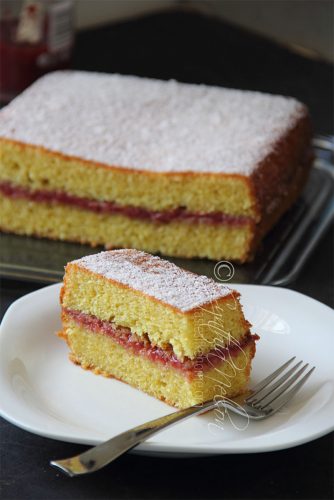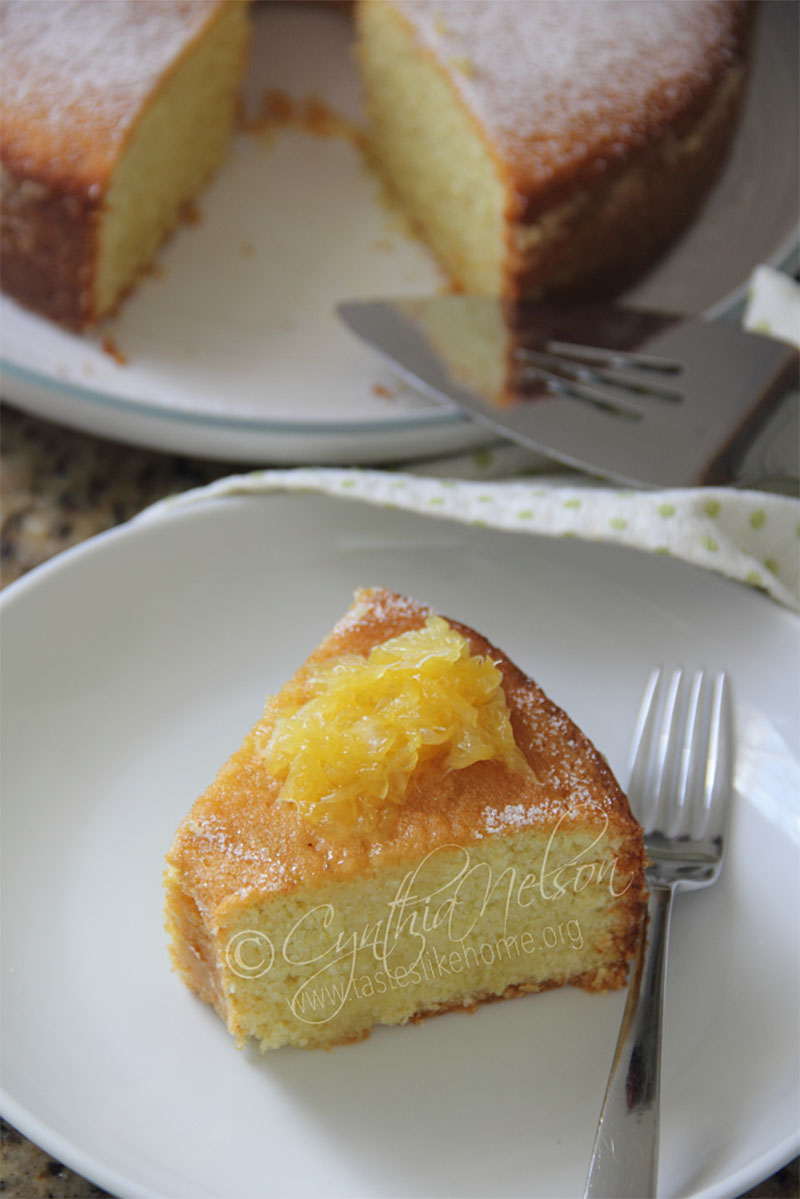 More than a decade ago, I wrote a column about the confusion between a sponge cake (which is what we call it in Guyana) and a pound cake. In other parts of the Caribbean, the sponge cake as we know it is also called Yellow cake (because of the colour of the crumb or sponge – the inside of the cake). In other parts of the Caribbean, it is known simply as Plain cake. Growing up, my mother always referred to this type of cake as a sponge cake. The only sponge cake I knew of then was the light foam cake leavened with only eggs, the whites beaten until stiff to give the cake its signature rise, and tender, almost delicate crumb, very much a sponge. I believed back then that we were confusing Pound cake (because of the similarity of look) by calling it a sponge cake. I was wrong. What we make is a sponge cake.
More than a decade ago, I wrote a column about the confusion between a sponge cake (which is what we call it in Guyana) and a pound cake. In other parts of the Caribbean, the sponge cake as we know it is also called Yellow cake (because of the colour of the crumb or sponge – the inside of the cake). In other parts of the Caribbean, it is known simply as Plain cake. Growing up, my mother always referred to this type of cake as a sponge cake. The only sponge cake I knew of then was the light foam cake leavened with only eggs, the whites beaten until stiff to give the cake its signature rise, and tender, almost delicate crumb, very much a sponge. I believed back then that we were confusing Pound cake (because of the similarity of look) by calling it a sponge cake. I was wrong. What we make is a sponge cake.
A show I like to watch on the Public Broadcasting Service (PBS) is the Great British Baking Show. There is so much to learn, marvel at, and enjoy. One of the items often being made on that show is a sponge (cake) for all sorts of creations, whether it is for the Signature challenge, Technical challenge, or Showstopper challenge — the title of each is self-explanatory. Under-standing that our cuisine, whether Guyanese or that of any other part of the Caribbean is influenced by various other cuisines throughout our history of colonization, it is safe to say that the Guyanese Sponge cake, the Plain cake, the Yellow cake has its roots in the British sponge cake, famously known as the Victoria Sandwich cake, Victoria Sponge or simply the sandwich cake/sandwich sponge. The “sandwich” in the name of the cake is because the batter is baked in two pans and the cakes are sandwiched together with jam in the middle. The recipe is very similar to what we make and the look and feel of the cake very similar. We have made it our own by the various flavourings we add, the type of pans we use, the quantity and size of the cake and opting for a one-pan cake instead of two cakes mounted one on top of the other with jam or butter cream, separating, yet uniting them.
According to food historian Alysa Levene, as reported in her 2016 book, Cake: A Slice of History, Queen Victoria was rather fond of the sponge cake and enjoyed having a slice with her afternoon tea. While the Queen is said to have enjoyed many other sweet delights, it was the simple sponge cake that took centre stage on her table above all others; by popularizing it, the cake was named in her honour. The invention of baking powder in 1843, lightened the sponge cake which was originally made with only sugar, butter, flour, and eggs. The light, risen sponge became a favourite and one of the most well-known cakes.
Recipes for a Victoria Sponge cake evolved from the classic pound cake, made with equal proportions of flour, fat, sugar, and eggs. A classic pound cake is dense and rich. Borrowing from this along with the addition of baking powder, the sponge was made lighter, and though the ratio of ingredients remained the same, though less, it meant that one could make lighter, softer cakes, sponge cakes. In other words, a sponge cake can be made with 6 ounces of butter, 6 ounces of sugar, 6 ounces flour and the equivalent of 6 ounces of eggs along with baking powder to give it an extra rise and lightness. If you look at the crumb of a Pound cake and that of a sponge cake, you can clearly see the difference, one is compact and the other airy and light. Pound cakes usually call for a pound of each ingredient.
Armed with all this information, I was keen to try making a British sponge cake, a Victoria Sponge. I turned to a recipe from the British queen of cakes Mary Berry, who was a long-standing judge on the Great British Baking Show. Before I go on, let me say this, just as the pound cake recipes are varied with the addition of other ingredients like ricotta, sour cream, yogurt etc. and the amount of baking powder and eggs vary from one recipe to another, so too have recipes for a sponge cake. In pursuit of perfect consistency, crumb, and flavour, debates rage about the use of self-rising flour versus plain flour to which baking powder is added. In some cases, such as in Mary Berry’s recipe, there is self-rising flour plus added baking powder for extra lightness to the sponge. Of course, these recipes are adapted even more these days with the use of cake and/or pastry flour making the sponges (cakes), even lighter. Some people take their sponges so seriously that they even weigh the eggs rather than estimating or averaging how many eggs they think is adequate for the sponge.
It is not only the ingredients that are debated but also the method of mixing. A lot of modern recipes call for throwing all the ingredients into a bowl, whisking to create the batter. Personally, I prefer the traditional method of creaming the butter with the sugar first then adding the eggs one at a time before gently mixing in the flour-baking powder mixture.
While I used Mary Berry’s recipe, I adapted it to suit my taste and changed up the mixing method. The sponge cake is different from the one I grew up eating and the one that I usually make. It was indeed lighter and tender. The self-rising flour that I used (which is what is readily available here) was cake flour and I believe that that may have contributed too to the tenderness of the cake. On the occasions that I’ve made the cake, I used different pans – all the batter in one pan for one cake and then the batter divided and added to two pans to create the sandwich cake. The taste testers and I enjoyed the cakes both ways and the one thing we all agreed on is that this version of the sponge cake begged for something a little extra, and that the jam sandwiched between the cakes was spot on. For the one-pan cake, I made a light pulpy orange syrup to go with the cake. An old-time favourite would have been a couple of heaping spoonfuls of canned fruit cocktail. Remember that?
Try the recipe and let me know what you think.
Cynthia
cynthia@tasteslikehome.org

Victoria Sandwich Cake
(Heavily adapted from Mary Berry)
INGREDIENTS
• 8 ounces white granulated sugar
• Zest of 4 – 5 oranges
• 8 ounces unsalted butter, room temperature
• 4 large eggs, room temperature
• 1 teaspoon vanilla essence
• 8 ounces self-rising flour (see notes below)
• 1 teaspoon baking powder (see notes below)
• Jam of your choice, room temperature
• Caster sugar or white granulated sugar, for dusting
DIRECTIONS
1. Preheat the oven to 350 degrees F with the rack in the middle.
2. Grease and line an 8-inch baking pan if making 1 cake, if not, grease and line 2 x 8-inch baking pans to make 2 cakes to be sandwiched.
3. Mix together the flour and baking powder and set aside.
4. Add sugar and zest into a medium to large bowl and using your fingers, rub the zest into the sugar. You will notice the sugar change colour and become very fragrant.
5. Add butter and cream butter and sugar until light and fluffy (5 to 6 minutes) if using a hand mixer, about 6 – 8 minutes if working by hand.
6. Add the eggs one at a time and ensure that each egg is fully incorporated before adding the next.
7. Mix in the vanilla.
8. Slowly add in the flour and mix gently until combined but do not over mix.
9. Transfer all the batter to one pan if making one cake or divide the batter evenly in the two pans; you don’t need to be exact. If you like, weigh the filled pans.
10. Bake for 20 minutes or until the cakes are golden brown and a skewer inserted comes out clean. The cakes are done when they are coming away from the edge of the pans.
11. Remove pans from the oven and let cake cool in their pans for 5 minutes before removing and placing on a wire rack to cool completely.
12. If you made two cakes to serve as a sandwich cake, place one cake upside down onto a plate and spread the surface with jam (as little or as much as you like). Top it with the second cake with the topside up, springle with caster sugar. Let sit for 5 minutes then cut and serve. This cake is even better the following day.
NOTES
• In place of self-rising flour, use 8 ounces all-purpose flour along with 2 teaspoons of baking powder.
• Using orange zest is optional, you can eliminate it altogether or use a citrus zest of your choice.
• If baking one cake, bake for 25 minutes but check at the 20-minute mark.
• Use whatever shape of pans you have; I used square 8-inch pans because that is what I have.
• In place of caster sugar or white granulated, you can use powdered sugar








